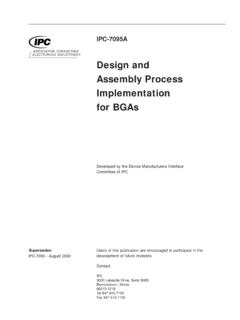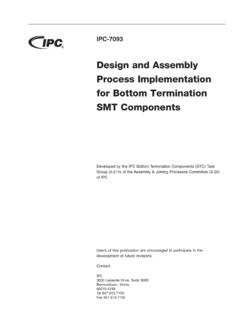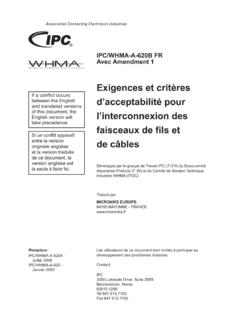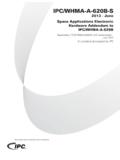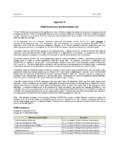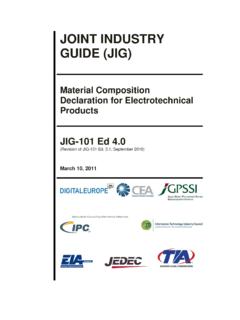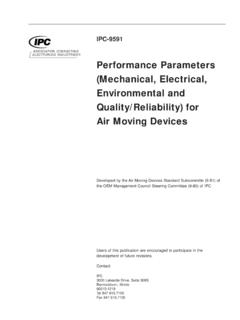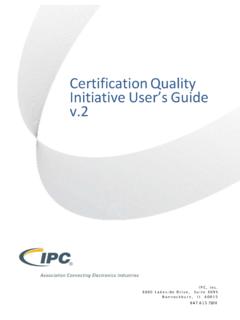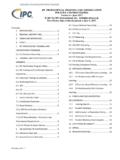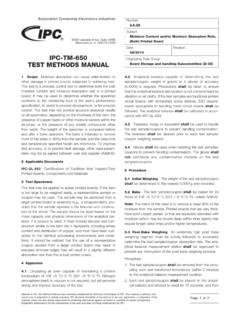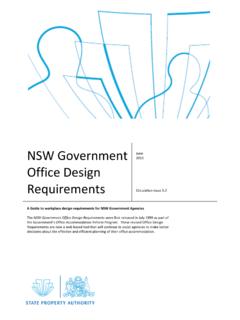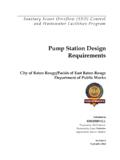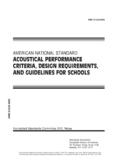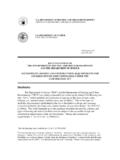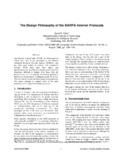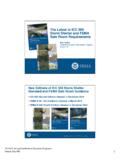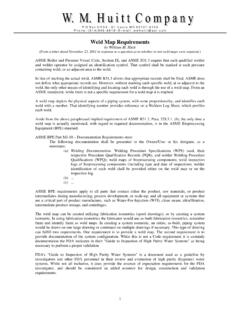Transcription of IPC-7251 Generic Requirements for Through-Hole …
1 IPC-7251 Generic Requirements for Through-Hole design and Land Pattern Standard 1st Working Draft June 2008 1 SCOPE This document provides information on land pattern geometries used for the Through-Hole attachment of electronic components. The intent of the information presented herein is to provide the appropriate size, shape and tolerance of through land patterns to insure sufficient area for the appropriate solder fillet around the lead to meet the Requirements of IPC/EIA J-STD-001 and the workmanship standard IPC-A-610, and also to allow for inspection, testing, and rework of those solder joints. Purpose Although, in many instances, the land pattern geometries can be different based on the type of soldering used to attach the electronic part, wherever possible, land patterns are defined with consideration to the attachment process being used. Designers can use the information contained herein to establish standard configurations not only for manual designs but also for computer-aided design systems.
2 Whether parts are subjected to wave, reflow, or other type of soldering, the land pattern and part dimensions should be optimized to insure proper solder joint and inspection criteria. Land patterns are dimensionally defined and are a part of the printed board (PB) circuitry geometry, as they are subject to the producibility levels and tolerances associated with plating, etching, assembly or other conditions. The producibility aspects also pertain to the use of solder mask and the registration required between the solder mask and the conductor patterns. Note 1: The dimensions used for component descriptions have been extracted from standards developed by industrial and/or standards bodies. Designers should refer to these standards for additional or specific component package dimensions. Note 2: For a comprehensive description of the given PB and for achieving the best possible solder connections to the devices assembled, the whole set of design elements includes, beside the land pattern definition: Solder mask Solder paste stencil Clearance between adjacent components Clearance between bottom of component and PB surface, if relevant Keepout areas, if relevant Suitable rules for adhesive applications The whole of design elements is commonly defined as mounting conditions.
3 This standard defines land patterns and includes recommendations for clearances between adjacent components and for other design elements. Note 3: Elements of the mounting conditions, particularly the courtyard, given in this standard are related to the reflow soldering process. Adjustments for wave or other soldering processes, if applicable, have to be carried out by the user. This may also be relevant when solder alloys other than eutectic tin lead solders are used. Note 4: Heat dissipation aspects have not been taken into account in this standard. Greater mass may require slower process speed to allow heat transfer. Note 5: Heavier components (greater weight per land) require larger lands; thus, adding additional land pattern surface will increase surface area of molten solder to enhance capabilities of extra weight. In some cases the lands shown in the standard may not be large enough; in these cases, considering additional measures may be necessary.
4 Documentation Hierarchy This standard identifies the Generic physical design principles involved in the creation of land patterns for Through-Hole components, and is supplemented by a shareware IPC Land Pattern Viewer that provides, through the use of a graphical user interface, the individual component dimensions and corresponding land pattern recommendations based upon families of components. The IPC Land Pattern Viewer is provided on CD-ROM as part of this standard. Updates to land pattern dimensions, including patterns for new component families, can be found on the IPC website ( ) under PCB Tools and Calculators. See Appendix A for more information on the IPC Land Pattern Viewer. Component and Land Pattern Family Structure The IPC-7251 provides the following number designation within this standard for each major family of Through-Hole components to indicate similarities in solder joint engineering goals: IPC-7252 Discrete Components (Axial and Radial Leaded Components) IPC-7253 Dual-in-Line Package (DIP) IPC-7254 Three Leaded Semiconductor IPC-7255 Pin Grid Array IPC-7256 Unique Multiple Function Parts IPC-7257 Connectors and Headers IPC-7258 Single Inline Package (SIP) Resistor Networks IPC-7259 Mounting Hardware Note: None of the families provided above are intended for release as separate publications from this standard.
5 They are intended for classification purposes only within this standard. Performance Classification Three general end-product classes have been established to reflect progressive increases in sophistication, functional performance Requirements and testing/inspection frequency. It should be recognized that there may be an overlap of equipment between classes. The end product user has the responsibility for determining the Use Category or Class to which the product belongs. The contract between user and supplier shall specify the Class required and indicate any exceptions or additional Requirements to the parameters, where appropriate. Class 1 General Electronic Products Includes consumer products, some computer and computer peripherals, and hardware suitable for applications where the major requirement is function of the completed assembly. Class 2 Dedicated Service Electronic Products Includes communications equipment, sophisticated business machines, and instruments where high performance and extended life is required, and for which uninterrupted service is desired but not mandatory.
6 Typically the end-use environment would not cause failures. Class 3 High Reliability Electronic Products Includes all equipment where continued performance or performance-on-demand is mandatory. Equipment downtime cannot be tolerated, end-use environment may be uncommonly harsh, and the equipment must function when required, such as life support systems and other critical systems. The IPC-7251 land patterns have the capability of accommodating all three performance classifications. Producibility Levels When appropriate this standard will provide three design producibility levels of features, tolerances, measurements, assembly, testing of completion or verification of the manufacturing process that reflect progressive increases in sophistication of tooling, materials or processing and, therefore progressive increases in fabrication cost. These levels are: Level A General design Producibility Preferred [Maximum land/lead to hole relationship] Level B Moderate design Producibility Standard [Nominal land/lead to hole relationship] Level C High design Producibility Reduced [Least land/lead to hole relationship] The producibility levels are not to be interpreted as a design requirement, but a method of communicating the degree of difficulty of a feature between design and fabrication/assembly facilities.
7 The use of one level for a specific feature does not mean that other features must be of the same level. Selection should always be based on the minimum need, while recognizing that the precision, performance, conductive pattern density, equipment, assembly and testing Requirements determine the design producibility level. The numbers listed within the tables of IPC-7251 are used in the IPC Land Pattern Viewer and are a guide in determining what the level of producibility will be for any feature. The specific requirement for any feature that must be controlled on the end item shall be specified on the master drawing of the PB or the PB assembly drawing. Land Pattern Determination This standard discusses two methods of providing information on land patterns and hole configurations: 1. Exact details based on industry component specifications, PB manufacturing and component placement accuracy capabilities. These land patterns are restricted to a specific component, and have an identifying IPC-7251 land pattern name.
8 2. Equations can be used to alter the given information to achieve a more robust solder connection, when used in particular situations where the equipment for placement or attachment are more or less precise than the assumptions made when determining the land pattern details (see ). Three land pattern, hole size, and lead extension geometry variations are supplied for each of the device families: Level A: Maximum Land/Lead to hole Relationship The maximum land pattern conditions have been developed to accommodate the most robust producibility of the solder application method. The geometry furnished may provide a wider process window for solder processes as well. The Level A land patterns are normally considered for low component density product applications. Level B: Nominal Land/Lead to hole Relationship The nominal land patterns furnished for all device families will provide a robust solder attachment condition for most soldering processes and should provide a condition suitable for wave, dip, drag or reflow soldering.
9 Products with a moderate level of component density may consider adapting the nominal land pattern geometry. Level C: Least Land/Lead to hole Relationship Selection of the minimum land pattern geometry may not be suitable for all product use categories. High component density typical of portable and hand-held product applications may consider the minimum land pattern geometry variation. The use of classes of performance (1, 2, and 3) is combined with that of levels (A, B, and C) in explaining the condition of an electronic assembly. As an example, combining the description as Levels 1A or 3B or 2C, would indicate the different combinations of performance and component density to aid in understanding the environment and the manufacturing Requirements of a particular assembly. Although all three land pattern geometry variations are considered compliant for lead free soldering processes, the Level C variant will require more process control to ensure a proper wetting of the lead free alloy.
10 It is important to note, however, that the primary issue of lead free relates to the surface finish on the PB and the component termination. See for further information on land pattern design in lead free soldering environments. Terms and Definitions Terms and definitions used herein are in accordance with IPC-T-50 except as otherwise specified. Note: Any definition denoted with an asterisk (*) is a reprint of the term defined in IPC-T-50. *Assembly A number of parts, subassemblies or combinations thereof joined together. (Note: This term can be used in conjunction with other terms listed herein, , Printed Board Assembly. ) Assembly, Double-Sided Packaging and interconnecting structure with components mounted on both the primary and secondary sides. Assembly, Multilayer Printed Circuit (Wiring) Multilayer printed circuit or printed wiring board on which separately manufactured components and parts have been added. Assembly, Packaging and Interconnecting (P&IA) Generic term for an assembly that has electronic components mounted on either one or both sides of a packaging and interconnecting structure.
